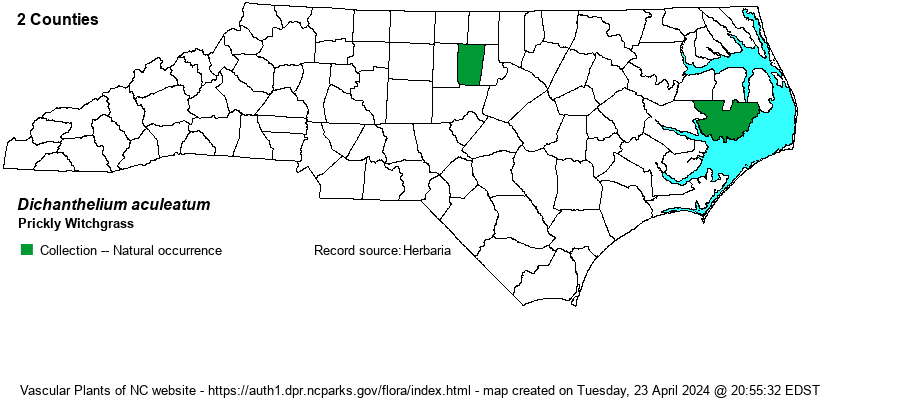| Author | (Hitchcock & Chase) LeBlond | |
| Distribution | See LeBlond (2019) for a discussion of this and related species. LeBlond cites specimens from Hyde and Orange counties, collected in 1906 and 1940, respectively.
Scattered from CT to NC on the Coastal Plain and lower Piedmont; disjunct to Ohio. | |
| Abundance | Apparently rare, but probably overlooked. Though there are no recent collections, the editors assume it likely still occurs in NC; it seems best to suggest a rank of S1? and a Watch List (W7) Status. It could just as easily be suggested as Historical (SH), but that implies some effort has been made to survey for it. | |
| Habitat | Near wetlands such as rivers, lakes, and swamps. | |
| Phenology | Flowering and fruiting May-Sept. | |
| Identification | See LeBlond (2019) or Weakley (2020) for keys. Most importantly, D. aculeatum spikelets are 2.8-3.4 mm long (vs. 1.8-2.8 in scabriusculum, cryptanthum, mundum, and recognitum). | |
| Taxonomic Comments | FNA treats it as a probable hybrid, which may have some merit given the scattered distribution.
A note about Dichanthelium: This genus is not impossible to identify to species! But it takes applied effort over a period of time in order to learn the various species and what their morphological limits are. We strongly recommend that you read the introduction to the treatment in Weakley et al. (2023), written by Richard LeBlond. LeBlond has made order out of near chaos, and his keys work very well for our plants. Most Dichanthelium taxa ("Dichs") do not grow everywhere indiscrimminately, but prefer certain well-defined habitats. Note that most species produce flowers/fruits twice a year -- a vernal period and an autumnal period -- and that measurements of spikelets and achenes are taken from vernal plants. Some species also have a third, or summer, period. In the vernal period there is a single inflorescence at the tip of the stem. In the autumnal period, plants produce elongate branches with bunched (congested) leaves and so look quite different from vernal plants. Inflorescences are produced in leaf axils as well as at the tips of branches. NOTE: Older texts had these species essentially all within the very large genus Panicum. "Dich" species are typically named as "Witchgrass" and Panicum species named as "Panicgrass". | |
| Other Common Name(s) | | |
| State Rank | [S1?] | |
| Global Rank | GNA | |
| State Status | [W7] | |
| US Status | | |
| USACE-agcp | | |
| USACE-emp | | |

